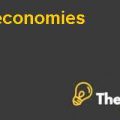MACROECONOMICS FORECAST OF BRAZIL:
Brazil is a country,particularly well suited in grasping the better understanding about the macro economics of the country, and reforms particularly in favor of the poor. The Brazilian economy faced a new economic environment with a lower growth rate in the developed countries that change relative prices. Despite the rapid growth of world trade, Brazil is preoccupied with the domestic market and it continues to flourish. Brazil’s economic situation fundamentally changed in 2000s, after a year when the Workers’ party won the presidency. (Avan, 2000)
After assessing the current situation, the forecasting of the real, fiscal, monetary and external accounts are differently obtained that are explained in different charts and graphs.
GDP GROWTH:
From 2010 to 2011, the world GDP growth fell and affected many countries.Brazil’s GDP in these years shows a negative trend -64% to -62%. GDP growth of Brazil accelerated since 1998 until 2006. The monetary policy indicates the Central Bank would take a step forward to sacrifice the economic growth in order to push inflation down. It is fore casted that GDP growth rate will continue to increase slowly from 2014 to 2019, and it will show a downfall in 2020 with -3.46%.
INFLATION RATE:
This trend shows that inflation rate will increase in the future years. To reduce inflation rate, the government slows the rate of the GDP.
TAX REVENUES:
A decrease in tax rates will increase government revenue. The tax system can have the board goal of reducing the consumer price index. The government should take action to reduce the tax because and this will lead to low consumer price index, which means increases in poverty and hunger.
DOMESTIC SECTOR:
Agriculture and Industrial sector of the country is progressing and this is the reason the domestic sector of the Brazil is in an increasing trend.
TOTAL DEBT SERVICES:
INCOME SHARE BY LOWEST 20%:
Apart from that, there are many indicators that are highly important in the macroeconomics growth of the country.
2. INTERNAL IMBALANCES AND EXTERNAL IMBALANCES:
Brazil’s economy prepared by IMF recommends Macroeconomics policy of Brazil framework and adopting measures geared increasing productivity and improving market competitiveness.In the last two decades, Brazil has shown effort to overcome the obstacles of the economic development and social welfare,but the macroeconomic performance in investment and growth is at decreasing trend. Inadequate infrastructure and imbalances in demand hampering the Brazil’s growth process. (Carlin, 2014)
In the last couple of years, measures to stimulate the economy of the Brazils did not produce a sustained economy. Industrial output is contracting and generating profits in the country.The exceptional performance of the labor market, redistribution of income and the eradication of poverty are the major achievements for the growth of the country. However, the pitfalls include fiscal weaknesses, low investment rate and sluggish growth. The consumption in Brazil has been strongly supported by low unemployment rate.
Brazil set the perfect example of the country, in changing macro economics policies after late nineteenth century. The Inflation target was introduced in 1999 and new fiscal policy reforms set up in 2000 by the Fiscal Responsibility Law, due to this in 2000 the inflation rate started showing progress in the decreasing trend. (Ernesto Talvi, 2000)
The net burden of the taxation showed a relatively small increase going up from 30% in 2002 to 55% in 2012. High taxation and deficit infrastructure are the fundamentals constraints and pitfalls for the higher rates of private investment. Brazil is independent on the commodity exports and risks, therefore, this increases the revenues from natural resources and that makes the currency stronger, imports cheaper and manufactured products more expensive.
Brazil’s deteriorating labor market is also suppressing the growth prospects. In recent years, Brazil’s economy lacked the job creation in 2008 which won’t increase the unemployment rate because the labor market participation rate was also falling. This falling trend is driven by great numbers of the student who are entering in the full time education.
However, agriculture and industrial sector made the Brazilian economy,and they are considered as one of the major beneficiaries. Export growth and the trade improvements are the engines of growth of the Brazilian economy.The country boasts a well-developed agriculture, mining, manufacturing and service sector. Service sector contributes a lot to the country’s economy followed by the industrial sector.
To reduce market imbalances of the Brazil, the government should revolutionize the growth rate. The authorities should formulate primary surpluses, country’s fiscal and monetary deficiency that will reduce the expenditures and treasury’s support to public bank........................................
This is just a sample partial case solution. Please place the order on the website to order your own originally done case solution.












